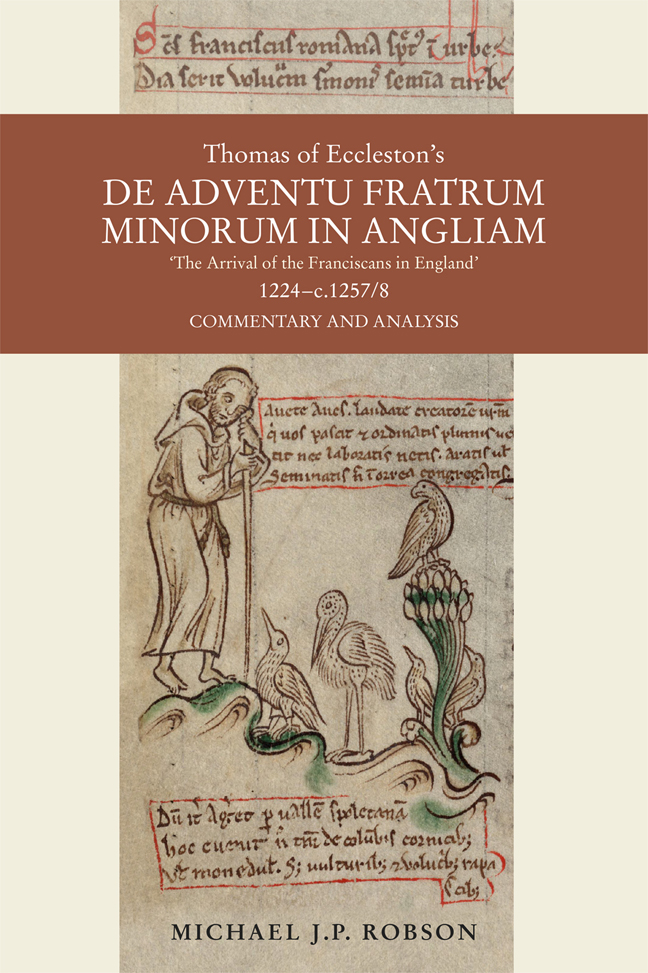Book contents
- Frontmatter
- Dedication
- Contents
- Acknowledgements
- List of Abbreviations
- Timeline
- Introduction
- 1 The launching of the mission to England
- 2 The first foundations
- 3 The admission of novices
- 4 The growth of the Franciscan community
- 5 The fervour of the early friars
- 6 The office of preaching
- 7 The seven custodies
- 8 The three general visitators
- 9 The Irish and Scottish provinces
- 10 The relocation of friaries and their enlargement
- 11 The friars’ schools of theology
- 12 The confessors
- 13 The ministers general
- 14 The ministers provincial
- 15 A gallery of friars
- A post script
- Bibliography
- Index
- Miscellaneous Endmatter
4 - The growth of the Franciscan community
Published online by Cambridge University Press: 02 March 2024
- Frontmatter
- Dedication
- Contents
- Acknowledgements
- List of Abbreviations
- Timeline
- Introduction
- 1 The launching of the mission to England
- 2 The first foundations
- 3 The admission of novices
- 4 The growth of the Franciscan community
- 5 The fervour of the early friars
- 6 The office of preaching
- 7 The seven custodies
- 8 The three general visitators
- 9 The Irish and Scottish provinces
- 10 The relocation of friaries and their enlargement
- 11 The friars’ schools of theology
- 12 The confessors
- 13 The ministers general
- 14 The ministers provincial
- 15 A gallery of friars
- A post script
- Bibliography
- Index
- Miscellaneous Endmatter
Summary
The friars’ good example, holiness of life and unswerving commitment to the dissemination of the Gospel were the keys to the respect and admiration in which they were held. They were seen to be injecting a new energy and vitality into the Church as they applied the lessons of the Gospel to urban life. In return, the laity responded by meeting the friars’ material needs by providing food and accommodation (loca sibi competentia). As indicated earlier, the first groups of friars were small enough to be accommodated in a house (domus). While as many as ten friars might be housed in adjacent properties, the expansion of the order brought change with it. The augmented communities of friars required more space and a greater range of amenities traditionally associated with the monastic world – a sacristy, a chapter house, a dormitory, a library, an infirmary, medical facilities, a muniments’ room, a refectory and one or more cloisters. The period between 1224 and 1274 saw a remarkable numerical expansion in the English province and this brought changes to the friars’ lives. The community was in the process of being transformed from a largely lay fraternity into a thriving institution whose pastoral ministry prospered. It spread, moreover, not only throughout the western Church, but it moved into missionary territories. The friars’ mission was apostolic and global; friars were seemingly ubiquitous with their poor tunics and bare feet. These changes could not be overlooked by Eccleston, who was instinctively drawn to the order’s heyday of the later 1220s and early 1230s.
Friars and their benefactors
In some towns such as Boston and Scarborough there was a single parish church, while cathedral cities such as London, Lincoln and York had multiple parish churches. Various allusions to the presence of the friars pinpointed the parishes in which they resided. The friars at Oxford lived in the parish of St Ebbe. The friars of London were initially in the parish of St Peter upon Cornhill, but a year later they moved to the parish of St Nicholas at Newgate. The parish of St Peter at Chichester was iuxta Fratres Minores. The parish of Holy Trinity below the hill at Lincoln was in Cleumarket iuxta Fratres Minores or ad fratres. The adjacent parish churches were Sts Edmund and Swithin.
- Type
- Chapter
- Information
- Thomas of Eccleston's De adventu Fratrum Minorum in Angliam 'The Arrival of the Franciscans in England', 1224-c. 1257/8Commentary and Analysis, pp. 87 - 99Publisher: Boydell & BrewerPrint publication year: 2023



